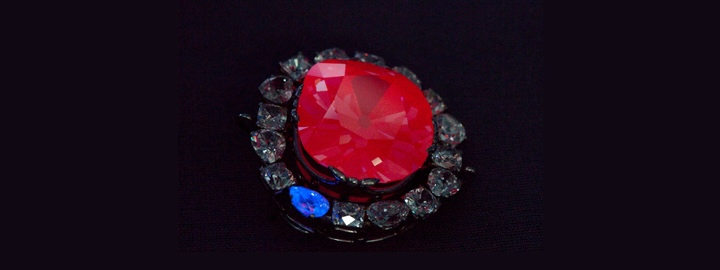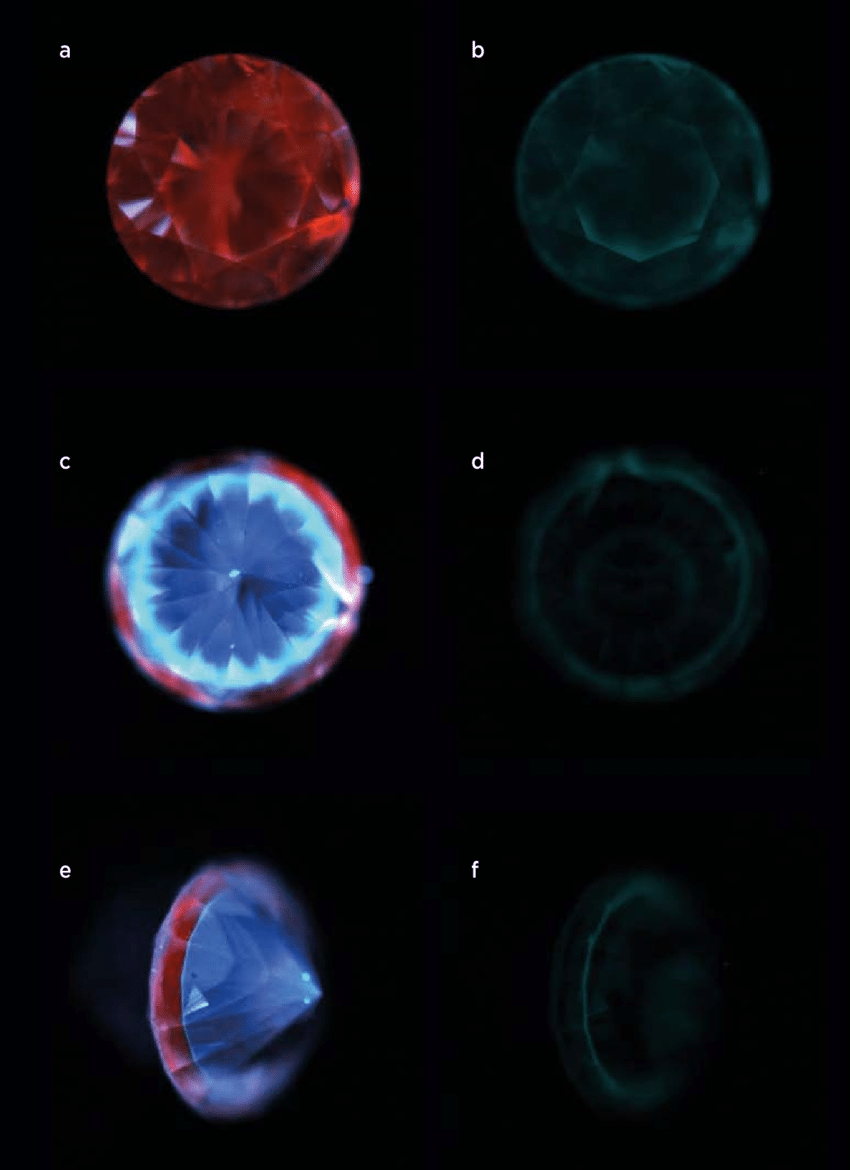When it comes to the allure of diamonds, their sparkle is not the only fascinating aspect. Beyond the brilliance that captures the eye, some diamonds possess unique optical properties that further enhance their mystique. Two such phenomena are fluorescence and phosphorescence, both of which occur in natural and lab-created diamonds. These traits can influence a diamond’s appearance under different lighting conditions, adding layers of intrigue to these already captivating gemstones. In this article, we will delve into the differences between fluorescence and phosphorescence, exploring how these effects manifest in lab-grown diamonds.
Understanding Diamond Fluorescence in Lab Diamonds
What is Diamond Fluorescence?
Diamond fluorescence refers to the phenomenon where a diamond emits a visible glow when exposed to ultraviolet (UV) light. This effect occurs due to imperfections or defects in the diamond’s carbon lattice, often associated with the presence of trace elements like nitrogen. These impurities cause some diamonds to absorb UV light and re-emit it as visible light, typically in shades of blue, although other colors can occur. This glow is observable only as long as the UV light source is present, ceasing immediately when the light is turned off.

Levels of diamond fluorescence under UV light, ranging from None to Very Strong, illustrating the intensity of the blue glow as classified by gemological standards.
In the context of lab-grown diamonds, fluorescence occurs similarly to natural diamonds. Approximately 30% of natural diamonds exhibit fluorescence, and lab-created diamonds can be engineered to display this effect, depending on the elements involved in their production process. Lab diamonds, just like their natural counterparts, can range from having no fluorescence to exhibiting faint to very strong fluorescence, which is typically indicated on a diamond grading certificate.
The presence of fluorescence in diamonds has been a topic of debate, particularly in the natural diamond market. Some argue that strong blue fluorescence can enhance the appearance of a diamond, making it appear more colorless by offsetting any yellowish tint. This can be seen as a benefit, particularly in diamonds with lower color grades. However, in some cases, strong fluorescence can also negatively impact the diamond’s transparency or create a hazy appearance, which may detract from its overall brilliance.
Exploring Diamond Phosphorescence in Lab Diamonds
What is Diamond Phosphorescence?
Diamond phosphorescence, while similar to fluorescence, is a distinctly different optical effect observed in some diamonds. Phosphorescence occurs when a diamond continues to emit light even after the UV light source has been removed. Unlike fluorescence, where the glow ceases immediately with the removal of the light source, phosphorescent diamonds can continue to glow for a period of time, ranging from a few seconds to several minutes. This prolonged glow is often in colors such as red, green, or blue, with the exact hue depending on the specific trace elements or defects in the diamond’s structure.

The striking red phosphorescence of the famous Hope Diamond, showcased in a rare view under ultraviolet light.
Phosphorescence is less common than fluorescence and is particularly notable in certain types of diamonds. For instance, the famous Hope Diamond, a natural fancy blue diamond, is well-known for its striking red phosphorescence. The presence of boron, a trace element responsible for the blue color in the Hope Diamond, is also linked to its phosphorescent properties.
In the realm of lab-created diamonds, phosphorescence is an emerging area of interest. As lab-grown diamonds can be produced with specific trace elements, such as boron, the potential for creating diamonds with unique phosphorescent qualities is significant. This capability allows for a new dimension of customization in lab diamonds, where consumers can choose diamonds that exhibit specific afterglow effects, adding to the gemstone’s mystique and allure.
In summary, while both fluorescence and phosphorescence are related phenomena, they offer different visual experiences in diamonds. Fluorescence provides an immediate and short-lived glow under UV light, whereas phosphorescence presents a lingering afterglow, continuing to captivate long after the light source is removed. Both effects, whether naturally occurring or engineered in lab diamonds, contribute to the unique charm and intrigue of these precious gemstones.
Curious about the science behind lab-grown diamonds? Explore the essentials of diamond certification, explore the differences between CVD and HPHT diamonds, and discover how light performance impacts your diamond’s brilliance. Check out our expert guides for all this and more:
Enhance your diamond knowledge today!
Diamond Phosphorescence vs. Fluorescence in Lab-Created Diamonds
Building on the understanding of fluorescence and phosphorescence in diamonds, it’s essential to delve deeper into how these phenomena are studied, their visual impacts, and their prevalence, particularly in lab-grown diamonds. While both effects involve the emission of light in response to UV stimulation, they differ significantly in their behavior and implications for diamond evaluation and consumer perception.

Fluorescence (left) and phosphorescence (right) images of the 0.11 ct sample are shown with the DiamondView instrument, as viewed table-up, table-down and obliquely through the pavilion. The CVD layer displays red fluorescence and greenish blue phosphorescence, while the natural diamond substrate emits deep blue fluorescence and no phosphorescence. Images by S. Tang.
Laboratory Study of Diamond Luminescence
In scientific settings, fluorescence and phosphorescence are meticulously studied using advanced luminescence spectroscopy. This method allows researchers to precisely measure the wavelengths of light that trigger these effects and those emitted by the diamond during and after exposure. This level of analysis helps in understanding not just the presence of these phenomena, but also their intensity, duration, and color. Some diamonds are capable of both fluorescing and phosphorescing, sometimes displaying different colors or intensities for each effect.
Visual Differences: Fluorescence vs. Phosphorescence
From a visual standpoint, the key difference between fluorescence and phosphorescence lies in the persistence of the glow. A fluorescent diamond will only emit light while it is being actively stimulated by a UV source. The moment the UV light is turned off, the glow ceases. On the other hand, a phosphorescent diamond continues to emit light even after the UV source is removed, glowing in the dark like a smoldering ember gradually fading away.
This lingering glow is what makes phosphorescent diamonds particularly intriguing. If you find your diamond glowing in a dark room without any visible light source, you likely have a phosphorescent diamond. This effect is more pronounced and of longer duration in lab-grown diamonds compared to natural ones, where phosphorescence is typically faint and brief.
Why Does My Diamond Glow at Night?
If your diamond emits a glow in complete darkness, it is likely phosphorescent. This can be particularly striking if the glow is intense, suggesting the diamond may be lab-grown, where phosphorescence is more common. Natural diamonds with noticeable and prolonged phosphorescence are exceptionally rare and highly prized for their uniqueness.
The Subtle Beauty of Diamond Phosphorescence
Phosphorescence in diamonds is a subtle and often overlooked phenomenon. It generally requires specific conditions to be noticed, such as a dark room immediately following exposure to a suitable light source. In most natural diamonds, this effect is faint and short-lived. However, the increasing prevalence of lab-grown diamonds has brought more attention to phosphorescence, as it tends to be stronger and more easily observed in these stones.
Why Is My Diamond Glowing Orange in the Dark?
If your diamond glows orange in the dark, you are witnessing phosphorescence resulting from specific atomic-level defects different from those causing fluorescence. This orange glow is particularly common in lab-grown diamonds and can be detected by exposing the diamond to light and then immediately observing it in complete darkness. Interestingly, some diamonds exhibit two different colors of phosphorescence that change over time, adding another layer of complexity to this phenomenon.
Phosphorescence Gradient and Its Significance
The intensity and duration of phosphorescence can vary depending on the light source and the diamond’s internal structure. For example, high-pressure high-temperature (HPHT) lab-grown diamonds often exhibit a strong phosphorescent effect, sometimes lasting several minutes. In contrast, the phosphorescence in natural diamonds is usually weaker and fades more quickly. The study of phosphorescence gradients in lab conditions reveals how different wavelengths of UV light, such as short-wave versus long-wave UV, affect the duration and color of the glow, further aiding in distinguishing between natural and lab-grown diamonds.
Does Phosphorescence Affect Diamond Quality?
While phosphorescence is an intriguing trait, it does not impact a diamond’s light performance or appearance under normal lighting conditions. However, because it is rare in natural diamonds, phosphorescence can carry a stigma in the lab-grown diamond market. This stigma is similar to that associated with blue nuance, a faint blue body color also related to boron impurities. Both traits can signal a diamond’s synthetic origin, which some buyers perceive as a drawback.
Phosphorescence in Lab-Grown Diamonds: A Common Phenomenon
Phosphorescence is more prevalent in lab-grown diamonds, especially those produced via the HPHT method, due to the presence of boron, an element often used in the growth process. Conversely, fluorescence, primarily caused by nitrogen impurities, is less common in lab-grown diamonds. The relationship between boron and nitrogen impurities plays a critical role in this dynamic, with nitrogen potentially suppressing phosphorescence in diamonds.
Conclusion: The Mystique of Phosphorescence
Phosphorescence adds a layer of mystique to diamonds, offering a unique visual experience that extends beyond the typical sparkle associated with these gemstones. While it is more common in lab-grown diamonds, its presence in natural diamonds remains a rare and fascinating occurrence. Despite its limited impact on a diamond’s overall quality, the phenomenon of phosphorescence—along with its associated market perceptions—continues to intrigue both scientists and consumers alike. Whether viewed as a flaw or a unique feature, phosphorescence in diamonds underscores the complexity and beauty of these remarkable stones.
Looking for the Perfect Lab Diamond?
Find out which retailer offers the best selection, quality, and value. Check out our in-depth reviews of top lab diamond retailers to make an informed choice:
Get the insights you need before you buy!
